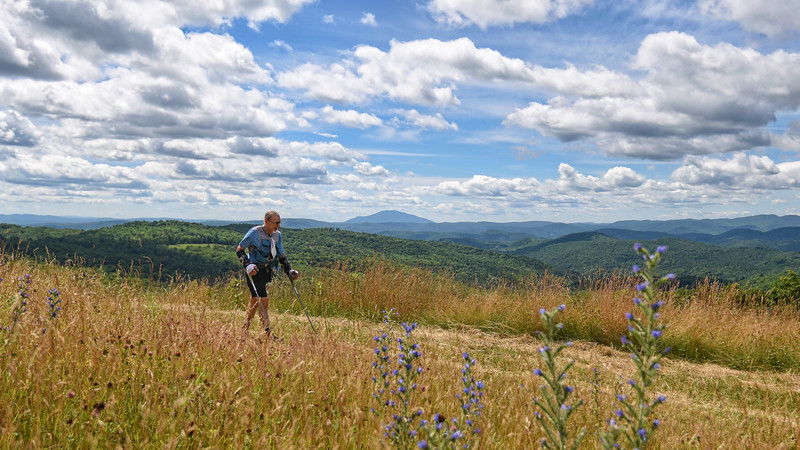Interview with ‘Nipmuck’ Dave
After race directing the Nipmuck Trail Marathon in Connecticut for 26 years and retiring from 30 years of Occupation Therapy work, adaptive athlete Dave Raczkowski finished last year’s VT100 on his handmade titanium crutches with 6 minutes to spare.
Tenacious and gritty, this interview reveals Dave’s humility (“I don’t know if I like being called a rockstar”), his backyard training regime (“I probably should be doing more hills”) and respect for the distance (“the VT100 doesn’t just happen during a few days in July”).
Here we go!
Q. Hi Dave. The Race Director wants to interview a few Vermont 100 rockstars. Would you mind answering a few questions?
I don’t know if I like being called a rockstar. I’m more of a spiritual advisor.
Q. Give us an idea of your training. Where do you train? How has your training been?
I probably should be doing more hills, but I find myself just getting in long runs. On Tuesdays, I run 4 hours and do 1 hour of weights. On Wednesdays, I run 6 hours. On Thursdays, I run 8 hours. I’m kind of procrastinating about doing the weights. I train in my ‘backyard’. I’m pretty satisfied [about] how things are going mainly because nothing hurts. I have a neighbor at the end of my road you always says, “Have a nice walk today,” and I wave, muttering under my breath, “I’m not walking, I’m running.”
Q. How many times have you finished Vermont? Do you have any advice for the first timers?
6 attempts, 3 finishes. The Vermont 100 doesn’t just happen during a few days in July. It’s all the time because I’m constantly training for it. So, first timers should choose very carefully where they live. As long as the house has a good roof and the toilet flushes, that’s good enough. That house should be in the middle of at least 10 square miles of woods with many miles of trails going through it. And take [the race] mile by mile. You can’t think of the whole thing. When you’re at mile 49, think about mile 49 – not mile 50 or 60.
Q. What is your favorite part of the event?
The first 10 miles and the very last mile. The worst time is from midnight ‘til 2:30AM before the race starts. I know I should be resting, but I’m just ready to explode. After the race starts that energy just flows out. That first 10 miles is effortless, more like floating. I don’t remember the specific aid station, but the one [where] some GAC members dumped a bucket of ice water over my head [editor’s note: Birmingham’s Aid Station, mile 53.9]. Arriving at Silver Hill is like having a circle that is almost completed. All the preparation has been done. Now you just let the events unfold in front of you.
Q. Do you have any advice for race directors on including an Athletes With Disabilities Awards Division at their ultra?
We mostly accept what we got and just deal with it. We want no special treatment.
Q. Do you consider yourself an adaptive athlete?
Very much so. I worked for 30 years as an Occupational Therapist in a Nursing Home, so adaptation is kind of like my middle name.
A Bit More
Dave will be running without a pacer (“when my mind is dark, it’s best to deal with myself”) and using handmade titanium crutches he had custom welded (“it was hard to find a guy who’d do it”).
When Dave isn’t running, he voluntarily maintains 22 miles of trails for the Connecticut Forest and Park Association but, he remarks, “my main pastime is being very much in love with my wife. She’s not a runner but we see eye to eye on a lot of stuff. As love affairs go, we got blessed.”
Nipmuck Dave, we’re all excited to meet you on Silver Hill Meadow and will be cheering you on to your next VT100 finish.
For more VT100 interview, race day prep tips, FAQs, and more, be sure to peruse the entire VT100 blog or use the category sorter at the top of the blog home to find relevant article!

